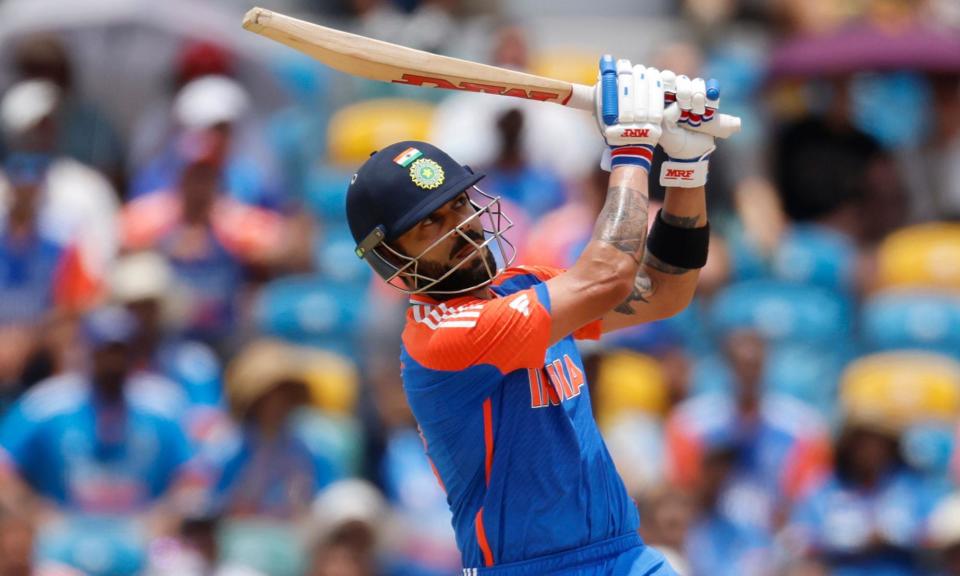South Africa’s search for absolution continues as Kohli finds formula

A quarter of a century has passed since that haunting drop of Allan Donald’s bat, that sight of canary yellow shirts in disbelief over their fortune, that run out to tie the match but eliminate South Africa from the World Cup.
Heartbreak after heartbreak followed, the most affecting since 1999 coming in 2015, with Dale Steyn spread across the Eden Park pitch, hands on head under lights, consoled by Grant Elliott. New Zealand’s South African-born batter had just ended his adopted nation’s own miserable sequence of last-four misery with a six down the ground.
Then came this, the promise of absolution. Rohit Sharma and Rishabh Pant went in the second over at the Kensington Oval, but the real eruption came with the dismissal of Suryakumar Yadav in the fifth, the ball plopping off the bat to find Heinrich Klaasen on the leg-side rope. Klaasen pumped his arms while still on the floor. Kagiso Rabada clenched his fists and roared. South Africa, under the momentary silence of India’s weighty support, were ascendant in their first men’s World Cup final.
Related: Resolute India beat South Africa in thrilling final to lift T20 World Cup
But this was never going to be decided early, particularly after India chose to bat first. Jasprit Bumrah, the best fast bowler in the world, would play in the second half. That would have to be the deciding passage.
Both sides entered the arena resembling the Spiderman-pointing meme. They had been fitter, faster, stronger and, most crucially, smarter than the rest. Both used 12 players, bringing in their wrist-spinners (Tabraiz Shamsi and Kuldeep Yadav) when campaigns moved from America to the Caribbean. Both found room for three left-handers in their top seven, spin to go both ways, left-arm pace and storied fast bowlers as frontmen (Rabada and Bumrah). Both teams were unbeaten after a month of playing the most volatile format of the game. Both deserved their place.
A tinge of desperation also lingered among them. It was obvious from a South African perspective, having never won the thing, making the nerves flowing through Marco Jansen’s opening over more than understandable. He overpitched, failed to adjust quickly, and watched Virat Kohli hit him right, left and straight for three fours in the space of five deliveries.
But this mattered greatly to India, too. Thirteen years without a World Cup victory has been a quirk of the modern circus, with one of these tournaments taking place every other week it seems. For Kohli, this remained a missing trophy in a staggering career but a match he walked into without his oldest friend: runs.
Seven innings had brought 75 runs, top-order aggression for the sake of the team costing the individual. The shortest form has moved on from the anchor in recent years, the mantra now to never relent, to get out early rather than cost your side with a run-a-ball half-century. Batting through 20 overs used to bring adulation; now it barely gets them a pat on the back.
But Kohli made a calculation after three quick wickets left South Africa triumphant in the powerplay. Desperation, of just making sure his team got to a somewhat competitive total, forced the return of the anchor. His 22 off 16 turned into a 40-ball 44 before a final flurry took him to 76 off 59, his work in this format for India completed when dismissed by Jansen with seven balls left.
In the old days this was, without hesitation, a brilliant innings. In today’s age of greedy enlightenment there was room to wonder if more time in the middle for Hardik Pandya would have served India better.
South Africa, in contrast, stuck to the modern path. Quinton de Kock celebrated moving to 22 with a slog-sweep for six. Tristan Stubbs, 23 years young, blitzed 31 off 21. David Miller kept on going and Klaasen was immense, having written a new page in the textbook about how to play spin off the backfoot. There was no time to dither, but Sharma waited until 30 was needed off 30 when he finally turned back to Bumrah for his final two overs.
India had miscalculated. But Bumrah’s genius was to fix it all, to concede six runs in two overs and leave Jansen statuesque. South Africa can add Yadav’s boundary-hopping catch next to the images of Donald and Steyn. Absolution still awaits.

 Yahoo Sport
Yahoo Sport 






































